 Leading Blog | Posts by Month |
 Leading Blog | Posts by Month |
12.31.19

LeadershipNow 140: December 2019 Compilation
See more on
Posted by Michael McKinney at 08:31 AM
12.27.19

How Good Leadership Can Impact Employees’ Innovative Behavior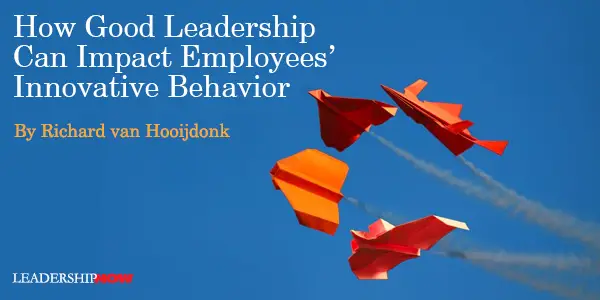
There’s increasing pressure on organizations to be more competitive, and leaders need to have the right skills to influence employees’ innovative behavior. GOOD LEADERSHIP is an important element in the success of any organization. Having effective leaders can help a company achieve its goals and maximize efficiency. In most cases, leaders have a profound influence on their employees. Besides helping them better handle workplace-related challenges, leaders evoke innovation and creativity and inspire them to reach their full potential. There’s been a lot of debate on whether leadership skills can be acquired in life or the person must be born with them. The answer is both. There are some people who seem to be born with great leadership skills, as well as those who developed them later in life. To encourage employees to become more innovative, leaders need to pay attention to a number of issues. Employee Motivation Leads to Better Decision-Making What can be increasingly hard for modern businesses is keeping employees motivated. A common trend among younger workers is switching jobs, and this is becoming a serious issue in the modern workplace. The generation that’s been criticized the most for being unattached to their organizations and their willingness to move from one job to another, are millennials. According to the analytics and advisory company Gallup, 21% of millennials have changed jobs within the past year. The main reason why the millennial workforce is so keen to switch jobs lies in their low engagement. Gallup reveals that 55% of millennials are not engaged at work. They don’t want to settle for less, and if they don’t get what they need and expect from their workplace, millennials will be more than happy to leave for a better opportunity. This creates a challenge for leaders who need to be very innovative to motivate this young workforce to stay. To motivate their employees, leaders first need to understand what drives them. During the hiring process, leaders can ask deeper questions to get a better sense of the strategies and techniques they could use to improve employees’ motivation and performance. Another effective way to make workers motivated is to give them the freedom of choice. This topic has sparked the interest of a professor of psychology, Edward Deci, who spent 20 years researching the field, and who discovered that “meaningful choice engenders willingness”. This will not only result in better decisions, but also increase the level of employee innovation. A study that analyzed innovative work behavior among service providers in Oman supports this claim. Based on responses from 320 employees, the study shows that employee motivation is a powerful tool to “mediate the relationship among leadership and employees innovative work behavior.” The Importance of Recognition Employee recognition also plays an important role in engagement. When employees get praised for their work and performance, they’re more likely to continue repeating that same behavior. Despite this, many managers and leaders make the same mistake. According to a survey conducted by the employee engagement platform Achievers, 43% of respondents say their managers are OK in giving recognition, while one in five admit their managers are horrible in giving proper recognition. Half of the respondents believe being recognized for their hard work has helped them improve their relationship with their bosses. Though companies usually offer perks and benefits to keep their employees happy, giving someone recognition for their hard work isn’t just about physical rewards. In fact, recognition is more about acknowledging employees for their contributions to the business. Creating a Culture of Transparency Besides employee recognition, what’s fundamental to business success is ensuring trust and transparency within the organization. Leaders who are more open and honest with their teams will empower employees to openly speak about issues that are affecting their performance. If there’s no trust within the organization, teams won’t feel engaged, and they’ll be less likely to take risks to solve specific problems. However, in a transparent and healthy environment that empowers employees to experiment, they’re more likely to succeed. Transparency will encourage collaboration among team members and make their work less stressful, because in a transparent work environment, they aren’t afraid to express their opinions. Meanwhile, if they’re constantly live in fear of being penalized for an error, they’ll be less proactive and won’t be able to think creatively. Final Thoughts The nature of work is changing, and organizations today are more agile and less hierarchical in structure than in the past. The role of leaders is about to change as well. Since there’s increasing pressure on organizations to be more innovative, leaders will need to find ways to influence employee innovation and improve their performance. Without the right leadership skills, this isn’t possible.  
Posted by Michael McKinney at 07:06 AM
12.25.19

Team Leader as Team Coach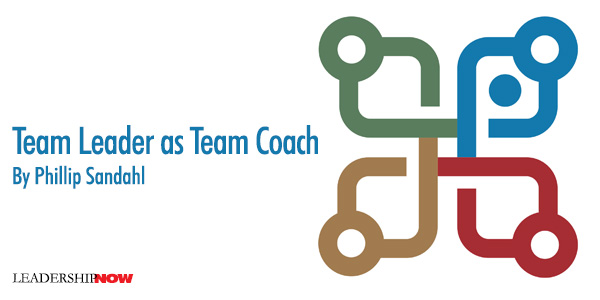
TEAMS HAVE PERSONALITIES. You know this from your own experience. Teams go through mood changes. No doubt you’ve felt it after a great team success or alternatively, the gloom and doom when things do not go as planned. It’s a team experience. It’s in the air. It’s mostly invisible, but it affects team performance. There’s an opportunity for leadership in that experience that is generally overlooked. Taking advantage of it as part of team development is an example of the skill set of team leader as team coach. Team leader as coach is not new. It’s a generally accepted leadership competency, working with individual team members, one-on-one. To that now familiar leadership style it’s time to add team leader as team coach: the ability to work with the team as a whole. The goals are similar: support, development, empowerment and ultimately improved team results. The difference is the environment and what that means in terms of skills needed to be effective. The Essential Mind Shift Where individual coaching is almost always a private, confidential dialogue between two people, team coaching happens publicly and in the moment with the whole team present. The conversation has multiple voices and the conversation between team members is just as important, often more important than the conversation between team members and team leader. In the midst of the team working on an issue that is timely and important at the content level, how the team interacts, how the team communicates and how that supports or undermines team performance, is showing up too. You are witnessing the team as a system, playing out team dynamics. It’s a challenge to shift your attention to this wider lens because of course, you’re an active part of the system too. But what it will give you is awareness of the underlying patterns that impact team behavior, and ultimately team results. Real World. Real Time. With a team coaching mindset, team meetings have two purposes: an action purpose and a learning purpose. The action is obvious: attend to the business. The learning purpose is about becoming more aware of the team dynamics. For example, take notice of how the team holds accountability. On your team, is it loose? Rigorous? Situational? Is it a mixed bag and different for different team members? How would you rate accountability on your team based on watching the team in action? Are you satisfied with that score? These are all good questions for your own consideration. They are also good questions to start an important team conversation. Facilitating that conversation is at the heart of team leader as team coach. Just as there are times when you need to be the commander as a leadership style, there are times to be a team coach, engaging the team and building a whole team culture. Intervening can happen during any team discussion when you notice a pattern, a mood change or a disruption in the flow. Obviously, it’s important that you focus on the issue at hand. Decisions need to be made; issues resolved. At the same time there is an opportunity to step back and watch the movie of how the team interacts. Is there permission, even encouragement for bold, out of the box ideas? Or is the team tentative? Based on what you’re seeing, how would you rate trust on this team? Skills for an Effective Team Coach The number one skill is curiosity. Set aside analysis and evaluation for a moment and just be immensely curious. In our training of team coaches we suggest that they imagine they are team anthropologists studying team behavior with a perspective of, “isn’t that interesting.” A second skill, related to being curious is to ask simple, open-ended questions. The best open-ended questions start with “what”, and the most powerful of all is, “what else?” By the way, “Say more” also works. Notice how important tone is when asking a question, especially when it comes from the team leader. Imagine the different ways this question could be delivered: “What made you think this was a viable option?” There is a curious version of that question and an accusatory one too, delivered with a bite. Remembering that here you are coaching the team as a whole rather than individuals, deliver the question openly, to the team. Avoid polling individual team members. A third skill is the practice of being a mirror to the team. This is a skill that includes clarifying, summarizing and active listening. It starts with your observation, “Here’s what I’m noticing…” and invites response from the team. “What do you see?” Or “Does anyone else see that?” Look and Listen Below the Surface That’s where the invisible forces of the team dynamics are at play. You are already well-practiced guiding and following the content level of a team conversation above the surface and get plenty of practice. That’s where the action happens. The learning for you and for the team happens by becoming more aware of what’s happening below the surface. The leadership competency of team coach creates a way to uncover the team dynamics that hold the team back from operating at its best.  
Posted by Michael McKinney at 12:33 AM
12.23.19

9 Lessons from Henry Ford’s $5 Day Decision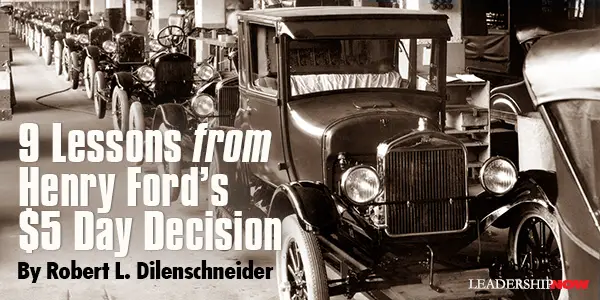
Any decision you make isn’t worth a tinker’s damn until you have formed the habit of making it and keeping it. IMAGINE that this is your situation: Your young company is a raging success. Its product, a simple one that can be produced easily because of a manufacturing process that you invented, is wildly popular. Then imagine that this is your problem: You have to replace your workers three or four times a year. Your great manufacturing process is driving your employees away. They can’t tolerate it! What would you do? Anyone who runs a business knows that a high employee turnover rate is . . . well, bad. The ability to attract and retain employees is key to longevity and success. How long can a business survive if its entire workforce turns over three or four times a year? As someone who has run his own business for over twenty-five years, I have many thoughts on this question. If my business had such a high employee turnover rate, do you think it would occur to me to double my employees’ wages? That’s what this particular business owner did. His name is Henry Ford, and we all know what the Ford Motor Company is. Maybe you bought one of the 2.5 million vehicles that Ford sold in the US last year. Let me set the scene, and then talk about the decision Ford made to save his company—a business decision that Fortune magazine said is the “greatest” of all time. Henry Ford founded his company in 1903 to manufacture vehicles for the “common man.” The automobile itself had already been invented—the adage “success has many fathers, but failure is an orphan” comes to mind, as there are several “fathers” of the first car (in fact, it was probably the German Karl Benz in 1885 or so). But in 1903, automobiles were an elite product. Only the rich could afford them. They were hand-built, often to personal specifications. They were also very heavy, as they had to withstand the rigors of mostly unpaved roads used by the horse-and-wagon mode of transportation. Though his was not the only automobile company, Henry Ford had some key early insights. He simplified the design and construction of the automobile, narrowed the choices available (“any color you want, so long as it’s black”) and marketed it toward what we would today call the “down market.” And as the American road system improved because more people were driving cars, the cars themselves could become lighter, a fact that Ford took advantage of. In 1913, Ford took a huge leap forward. He abandoned the traditional hand-building process that involved each worker performing a number of different tasks to put a car together. That was inefficient! Especially when demand for Ford’s products was ballooning — workers could not work fast enough. Instead of having the car-in-process stay in one place on the factory floor, with workers walking around to different locations to get what they needed and then walking back to the car, Ford instituted the “assembly line.” The car-in-process would be dragged or pushed or otherwise conveyed along a line. Workers would stay in one place, performing one task. Upon completion, the car would move along to the next group of workers, who would perform another task. Revolutionary! More efficient! And, at first, easier on the workers. But workers began to lose the sense that an entire car was emerging under their hands. Doing the same task over and over was not as satisfying. And as assembly-line technology improved, so too did its speed, which soon became a source of great stress. The workers could hardly keep up. And thus was born the problem of high employee turnover. Almost as soon as they learned what to do on the job, workers decided that they did not want the job. Only a year after Ford’s revolutionary invention, it was obvious that the assembly line had a huge unforeseen downside. Ford’s company was in a precarious position. The cost of finding and retraining workers was becoming crippling. The efficiency that was the promise of the assembly line could not be sustained. Both revenues and profits were beginning to decline. It’s interesting to me that Ford’s solution was not to change the nature of the assembly line. As I noted at the very beginning of this chapter, Henry Ford both made and kept to his decisions. We have seen this trait in other key decision-makers. Ford believed in his invention. But his invention depended on human beings, not robots (remember, this was 1914). If Ford’s employees were not thriving, then he would have to change the conditions under which they worked. Make the conditions more attractive. Raising pay was the obvious first step. “The $5 Day” came at a time when most assembly line workers were making about $2.50 a day. This wage-doubling was not arbitrary. Ford and his advisors determined that anything less would not be an effective incentive, and anything more would begin to depress profits. An additional $2.50 was the sweet spot. A related initiative was the three-shift per-day schedule (rather than two), which opened up more actual jobs. The “$5 Day” not only solved Ford’s immediate problem. Deceptively simple, his decision also sowed the seeds of the culture of consumerism that pervades, even defines, our lives today. For good or ill. That’s why Fortune’s editors named it as the ultimate in their 2012 book The Greatest Business Decisions of All Time. Earning $5 a day, Ford’s workers could finally afford to buy that Model T they were making. Henry Ford was nothing if not a visionary, iconoclastic, and decisive businessman. Even early in his career, he possessed those qualities, and his reputation only grew throughout his lifetime. Today, seventy-two years after the founder’s retirement and seventy years after his death, Ford is one of the great companies of our time. Do you think Henry Ford, as astute as he was, had any inkling what his 1914 decision to double his workers’ wages— in today’s parlance, to pay his workers a living wage—would mean? 9 Lessons Here are the top lessons I take from Henry Ford’s $5 Day decision that can apply to us:
 
Posted by Michael McKinney at 07:56 AM
12.16.19

The #1 Tactic That Will Help You Be More Productive as A Leader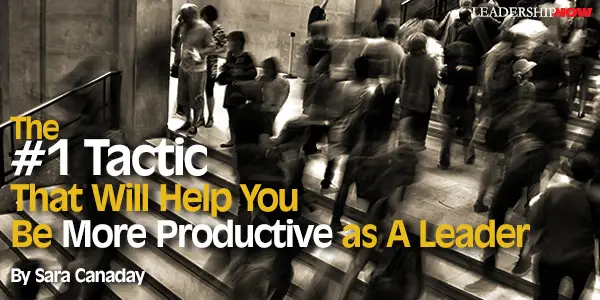
FOR THE PAST DECADE or so I have spent a lot of time in organizations getting to know their leaders and how they work. That inside look has given me a firsthand account of what they are dealing with on a daily basis. Suffice it so say, this is not your father’s organization. For example, the amount of incoming communication is staggering. The average knowledge worker in the U.S. is interrupted every 11 minutes by some form of communication. Every 11 minutes! That kind of distraction takes an unseen toll on us as leaders. Add to that the mountains of data we are generating and the inability to keep up with it, let alone make real sense of it. Today’s leaders are being asked to both do more AND think more. Is that even possible? I’m a fan of multi-tasking but this seems unreasonable. Expecting leaders to succeed in the context of a constant, act-more, think-more, produce-more world is self-defeating, at best. At worst, it could be disastrous for our projects, for our teams, and for our health. So, how do we keep pace and, at the same time, get better as leaders. Evolved leaders have figured out that they need to hit the pause button. Instead of making action the default for every challenge, these leaders are pairing that alternative with an opposite response. It’s not about replacing action, which we know is a necessary leadership ingredient. We still need to reach our goals, meet deadlines, and produce results. This is different. They think of it as developing a companion habit that celebrates THINKING rather than DOING. It involves a strategic pause. A “mental time-in”. Space for their brains to percolate and process the mounds of the information they’ve been packing in. If you want more time for big-picture-thinking and the “mental space” to envision vastly different solutions, follow these steps: 1. Make an Unbreakable Appointment with Yourself Set time aside every day (or at least every week) to step away from the chaos and let yourself reflect and plan. To connect the dots between information in different ways and to look at challenges from a fresh angle. It can help you gain remarkable clarity and give you the mental space to finally execute on ideas you’ve been sidelining. Yes, I know that will feel awkward at first. Your calendar is probably jam-packed with meetings and commitments, so it might seem unnecessarily selfish to mark off some “me time.” Don’t let that stop you. Consider this an unbreakable appointment with yourself. 2. Make everything you do earn its rightful place on your calendar Why? Leaders often feel trapped by an endless treadmill of meetings and tedious paperwork and that level of chaos has likely become their new normal. Even strangely comfortable. In fact, NOT doing all of those things would somehow feel wrong. If you want to free up time to let all that you have consumed percolate, you need to take a fresh look at everything you do. Ask yourself: • Does this meeting or task move me or my team forward?
Taking a fresh look at everything inevitably uncovers opportunities to free up time for big-picture thinking. 3. Make a “Stop Doing” List Ironically, some leaders approach downsizing their to-do lists by…creating another list: a “Stop Doing List.” This is actually an excellent mental exercise and an important step in making room for a “mental time-in”. Your “Stop Doing List” might include things such as: I will stop saying “yes” to every request without first considering its worth. Through the process of letting go, you can find time you never knew you had. 4. Encourage your team to pause. As a leader, you have the power and influence to help your team members develop new habits that can make them more productive. Make sure they also have time in their schedules to stop and think. That’s tricky when deadlines are tight, but the long-term benefits will be worth it. Give them the calendar space that encourages them to give it a try. As hard as it is for us doers to believe, all the evidence says that maximum effectiveness and innovation start with…STOPPING. Yes, it’s tough to do. I admit it. We’ve been taught to move forward, to finish, to be relentless. We have even been handsomely rewarded for it. But if you want your organization and your team to grow, take a strategic pause. Give yourself time and space. You, your team, and all your stakeholders will be glad you did.  Her insights come from her real-world experience and a surprising phenomenon she noticed in her own rise up the corporate ladder: The most successful people aren’t necessarily the ones with the highest IQs or best job skills. Career advancement is actually more closely linked with how people apply their knowledge and talents—their capacity to collaborate, communicate, and influence others. Sara is the author of Leadership Unchained: Defy Conventional Wisdom for Breakthrough Performance and You—According to Them. She is a sought-after leadership speaker and educator, a leadership instructor for LinkedIn Learning and is an adjunct Executive Coach with the Center for Creative Leadership.
Posted by Michael McKinney at 09:03 AM
12.13.19

The Best Leadership Books of 2019LEADERSHIP development is a lifelong process. It is made possible with a quality that we spend a lifetime acquiring: self-awareness. People don’t experience our intentions; they experience our behavior. It is a theme that runs through most of these titles. Books like Helping People Change and The Power of Bad, have the power to change forever how we work with others and address the things that hold us back. Grace is a tough concept to sell in today’s environment. Grace looks at the bigger picture. It is not primarily concerned for the self. It does not rejoice in the downfall of others. It does not seek its own way. It is outwardly focused. We marginalize others when we insist on our rightness. The need for an outward focus is the underlying conclusion of these titles. The biographies on this list are more than mere memoirs. They all provide insights into leading and how others have tried to make sense of the world. They all share their methods, their successes and failures, and the lessons they learned. Biographies provide, like no other genre, roadmaps and guardrails in a context that makes them relevant for our own lives. It’s like having a mentor guide your journey. When we get our thinking right, the success comes almost automatically.
(Page Two, 2019)
(Indigo River Publishing, 2019)
(Rodale Books, 2019)
(HarperCollins Leadership, 2019)
(Penguin Press, 2019)
(Portfolo, 2019)
(HarperCollins Leadership, 2019)
(Harvard Business Review Press, 2019)
(PublicAffairs, 2019)
(Riverhead Books, 2019)
(CenterPoint Publishing, 2019)
(Currency, 2019)
(TarcherPerigee, 2019) by Amy Jen Su (Harvard Business Review Press, 2019)
Biographies:
(Baker Books, 2019)
(Random House, 2019)
(Random House, 2019)
(Greenleaf Book Group Press, 2019)
(Simon & Schuster, 2019)
(Little, Brown and Company, 2019)
Posted by Michael McKinney at 06:57 AM
12.11.19

3 Ways to Boost the Effectiveness of Your Leadership
THE RESPONSIBILITIES that fall under a leadership title vary significantly at each company. Still, one thing is true for all—organizational leadership must be effective for teams to succeed. Without effective leadership in place, organizations can’t achieve their goals, and employees may start looking for jobs elsewhere. Leaders are often tasked with many projects that overload their schedules, which can prevent them from effectively leading and managing their team the way they should. There is also a noticeable gap in skills and training for leaders today. Closing the gap on leadership skills is the number one priority of 58% of companies, while only 18% feel their leaders are “very effective” at achieving business goals. By finding a practical approach to invest your time into the right priorities, the efficiency at which you perform your role, and respect your team has for you, can improve significantly. Let's take a look at three leadership strategies you can implement today to boost the effectiveness of your leadership. 1. Become more self-aware It's easy to fall into a rut in your position, but it’s harmful to the organization and your team when your leadership is on autopilot. Blind leaders often get tunnel vision, causing them to forget what's going on around them. While it’s easy to blame an individual team member for being negligent and causing a mistake, it’s important not to assume you are right. Having an open and consistent dialogue is crucial. Many leaders don't account for blind leadership. Neglecting an employee by providing minimal feedback and support is an issue that lies within the management position, not the employee. A strong leader is often characterized as someone able to identify their unique strengths while also having the courage to acknowledge their weaknesses. Self-awareness is a skill that can be learned over time through reflection. Many of the world's most successful leaders take time for self-reflection each day. If you’re not aware of your own actions, you can’t expect to fully understand what is happening with your team. 2. Foster an environment for employee growth Your position as a leader goes far beyond team management. Everyone wants to move up in their career. Your team will likely turn to you for guidance in getting to the next step on their path. You must foster an environment where employee growth is encouraged. One of the best ways to understand what your staff are looking for is to host ongoing career conversations. Inquire about your employees’ goals and where they see themselves growing in the company. Knowing this can help you develop a path for their career growth together. Delegating tasks to employees that are outside of their standard job description is another way to foster employee growth. This will help them develop new skills that can be applied to higher positions at the company when they are ready. By relinquishing control of some of your tasks through delegation, you will have more time to engage with your team. Delegation and management are often the most challenging aspects of a leadership position, but using an Enterprise Resource Planning (ERP) solution can help you manage your business processes and assign the associated tasks to the right people. ERP systems help increase efficiencies to drive better decision-making over time, allowing you to spend more time focusing on being an effective leader. Furthermore, you should be providing and obtaining constant feedback from your team. Most employees may feel that they do not receive enough feedback, and when they do receive any, it's too vague. Companies that provide consistent feedback have been shown to have less employee turnover. When employees feel respected, they become more engaged in the success of the company and their role in that success. Because of this, it's important to motivate and inspire your employees through ongoing, regular feedback. 3. Communicate effectively and often Leaders who do not communicate effectively regularly fail in their positions. Many may argue that communication is the most critical aspect of the job. You can start by being an active member of the conversations that you have with each of your employees. It's easy to get distracted when you're busy balancing many tasks at once, but your employees deserve your undivided attention during meetings. Make sure you're mindful of the fact that your team members have different communication styles. Actively listening to your employees and directly asking them to specify their preferred methods of communication can be helpful ways to understand your employees better. Being able to adapt your communication style to fit your team is a tremendous step toward becoming an effective leader. Not all leaders can manage relationships with their staff effectively. Don’t fall into this category! Prioritize your goals so you can allow time in your schedule for open office hours where employees can stop by unannounced for assistance or to talk through an issue. This transparency and willingness to be present can be invaluable to your employee's trust. There will be times when you deliver an important message to your team, and they may have questions for you. Be ready to answer these questions as openly and honestly as you can and always treat everyone with respect.
Posted by Michael McKinney at 07:56 AM
12.09.19

Asking Smart Questions Changes Everything
WE LIVE IN A TIME when accountability is often sidelined. When it is, there can be disastrous consequences in government, in politics, in the media, and in business. The antidote, I’ve found during my two decades as an accountability speaker and business consultant, is a thoughtful and persistent effort to infuse accountability into every objective, every task, and in every colleague-to-colleague and company-to-customer interaction. For the world-class companies that do this well, accountability isn’t an esoteric mandate handed down from senior leadership. Instead, it is a systemic root-to-tip effort that makes accountability an organic state of being that is cultivated on a daily basis by everyone within the organization. And believe it or not, it doesn’t take a Herculean effort. Accountability is easily nurtured by curiosity. Simple Questions are the Seeds of Accountability As a writer and accountability speaker, I stress the importance of my Seven Pillars of Accountability™: character, unity, learning, tracking, urgency, reputation, evolving. Every member of an organization can build and strengthen accountability by asking fundamental questions related to these pillars. Ask your peers and colleagues. Ask your immediate supervisor and members of the senior leadership team. Their answers, along with your own, will create a blueprint for better performance. Here are some starter questions to help you begin cultivating the mindset that builds accountability. You don’t have to be a management expert, accountability speaker or business guru to be a catalyst for excellence. The important thing is to begin the discovery process that fosters it. Character
Unity
Learning
Tracking
Urgency
Evolving
Asking Isn’t Easy
While good leaders may solve problems, great leaders ask questions. In fact, great leaders create an environment where questions, especially tough questions, are welcomed, asked, and answered before decisions are made and after results are assessed. Are you ready to start asking smart questions in your organization? That’s A Great Question With years of first-hand experience, and in working closely with a variety of organizations, both leading and emerging, I’ve collected a list of over 500 provocative questions that explore 18 compelling topics centered around leadership and business. These questions, and other insights, are compiled in my book, That’s A Great Question: Are You Asking The Right Questions In Business? In Life? If you’re ready to take that next step towards becoming a great leader, this book will guide you in asking smart questions. 
Posted by Michael McKinney at 08:20 AM
12.06.19

3 Things You Need to Control to Succeed as a Leader
SUCCESSFUL LEADERS know that we can control only 3 things in our life: our thoughts, feelings, and behaviors. If we can take charge over those, we can lead our organizations, and our lives, to our own vision of success. That vision may differ for successful leaders: some want to grow their business into a huge company, while some want to stay small and keep a family atmosphere in their company. Regardless of how you view success, to achieve it you need to invest into understanding how your mind works. Then, you need to direct your thinking and feeling patterns, and the behaviors that result, to evaluating reality clearly, making the wisest decisions, and accomplishing your goals. So how do our minds work? Intuitively, our mind feels like a cohesive whole. We perceive ourselves as intentional and rational thinkers. Yet cognitive science research shows that in reality, the intentional part of our mind is like a little rider on top of a huge elephant of emotions and intuitions. Roughly speaking, we have two thinking systems. Daniel Kahneman, who won the Nobel Prize for his research on behavioral economics, calls them System 1 and 2. I think autopilot system and intentional system describe these systems more clearly. The autopilot system corresponds to our emotions and intuitions. Its cognitive processes take place mainly in the amygdala and other parts of the brain that developed early in our evolution. This system guides our daily habits, helps us make snap decisions, and reacts instantly to dangerous life-and-death situations, like saber-toothed tigers, through the freeze, fight, or flight stress response. While helping our survival in the past, the fight-or-flight response is not a great fit for modern life. We have many small stresses in our work that are not life-threatening, but the autopilot system treats them as saber-toothed tigers. That produces an unnecessarily stressful everyday life experience that undermines our mental and physical well-being. Moreover, while the snap judgments resulting from intuitions and emotions usually feel true because they are fast and powerful, they often lead us wrong in systemic and predictable ways. For example, we make bad hires if we rely on our autopilot system. The autopilot system leads to us making too-optimistic plans and ignore weaknesses and threats in our businesses and our careers. It leads us into errors in negotiating with others, in mergers and acquisitions, and in assessing company performance. True leaders learn to avoid simply trusting their gut to address autopilot system errors. By contrast, the intentional system reflects our rational thinking, and centers around the prefrontal cortex, the part of the brain that evolved more recently. According to recent research, it developed as humans started to live within larger social groups. This thinking system helps us handle more complex mental activities. These include managing individual and group relationships, logical reasoning, probabilistic thinking, and learning new information and patterns of thinking and behavior. Notice how these activities are exactly the kinds of things necessary for leaders to succeed. While the automatic system requires no conscious effort to function, the intentional system takes deliberate effort to turn on and is mentally tiring. Fortunately, with enough motivation and appropriate training, the intentional system can turn on in situations where the autopilot system is prone to make errors, especially costly ones. The autopilot system is like an elephant. It’s by far the more powerful and predominant of the two systems. Our emotions can often overwhelm our rational thinking. Moreover, our intuitions and habits determine the large majority of our life, which we spend in autopilot mode. And that’s not a bad thing at all – it would be mentally exhausting to think intentionally about our every action and decision. The intentional system is like the elephant rider. It can guide the elephant deliberately to go in a direction that matches our actual goals. It can help you address the systematic and predictable errors that we make due to how our brain is wired, what scholars term cognitive biases. Over 100 cognitive biases exist, and more are found all the time by scholars in behavioral economics and cognitive neuroscience. We make these mistakes not only in work, but also in other life areas, for example in our shopping choices, as revealed by a series of studies done by a shopping comparison website. Fortunately, recent research in these fields shows how you can use pragmatic strategies to notice and address these dangerous judgment errors. The elephant part of the brain – which is most prone to cognitive biases – is huge and unwieldy, slow to turn and change, and stampedes at threats. But we can train the elephant. Your rider can be an elephant whisperer. Over time, you can use the intentional system to change your automatic thinking, feeling, and behavior patterns, and reach true success!  
Posted by Michael McKinney at 12:02 AM
12.04.19

Our Stewardship Responsibility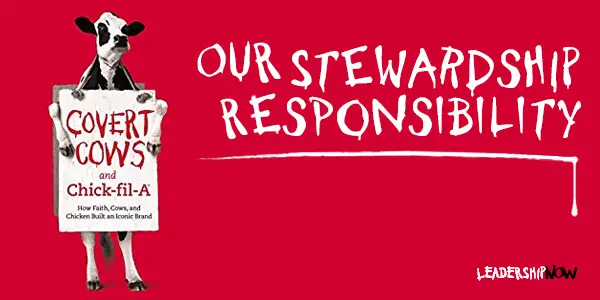
THE CHICK-FIL-A corporate purpose statement goes like this: To glorify God by being a faithful steward of all that is entrusted to us and to have a positive influence on all who come into contact with Chick-fil-A. In Covert Cows and Chick-fil-A, former executive vice-president and chief marketing officer, Steve Robinson explains that for Truett Cathy, founder of Chick-fil-A, the most important phase in the purpose statement was, “by being a faithful Steward.” And the most important word in that phrase was “by.” His premise was this business does not glorify God unless it is built upon great stewardship of the assets, talents, influence, and relationships entrusted to us. He felt accountability to his Creator—accountability for everything the Creator put into his hands and, thus, our hands—so he wanted a business that focused on doing those things well. Caught up in our day-to-day work, the idea of stewardship easily moves into the background. For Chick-fil-A, it guides everything they do. Even when drawn into controversy, regardless of personal beliefs, they act as stewards and, therefore, the need to have a positive impact on all who come into contact with Chick-fil-A. That’s the power of a clear purpose statement. “We were not a Christian business,” writes Robinson, “but rather a business where the owners and leadership aspired to apply and live out biblical principles.” Truett said that they weren’t a ministry and that he wanted “people to discover what we believe because of how we treat them.” The stewardship idea guides their marketing. Marketing is about more than transactions. It’s about relationships. When you’re building a brand based on emotional engagement rather than transactions, an investment at the personal engagement level is many times more efficient and effective than a media-weighted strategy. They contacted Horst Schulze and Danny Meyer to better understand service and hospitality. Horst told them, “Don’t look to be better than the other fast-food restaurants. Those limited expectations will just weigh you down. Instead, aspire to the next level of service—restaurants with a price point that are at least double Chick-fil-A’s, and build a service model that resembles those.” That mindset led them to create the Core 4: create eye contact, share a smile, speak with an enthusiastic voice, and stay connected to make it personal. The Cow Campaign The iconic Cow “Eat Mor Chikin” campaign developed from an idea by David Ring of The Richards Group. It is, as Robinson describes—engaging, endearing, and enduring. Stewardship comes into play here too. A former Chick-fil-A marketing consultant said, “They don’t wavier. They don’t shift. That is refreshing, and from a marketing standpoint, it can be very valuable, as you can see with the Cow campaign. They have resisted the urge to gussie it up, to change it, to get rid of it, or to do the wrong thing with it.” We also took great care ensuring the Cows never became shills for Chick-fil-A. They were in this thing for their own self-interest, not Chick-fil-A’s. If their work started to look too much like they were advertising for Chick-fil-A, such as promoting specific products and ingredients, they would quickly lose their edginess and even their believability. The cows are not on the Chick-fil-A payroll. Six Legacy Principles These six principles, based on Truett Cathy’s leadership, have guided every decision at Chick-fil-A and help to keep it uniquely different. 1. Being a Good Steward
2. Building Long-Term Relationships
3. Providing Hospitality
4. Taking Personal Responsibility
We were personally accountable to him, to the brand, and to our customers. We were accountable in the deals we created, in the relationships we built in the business, in our behavior on the road, in how we talked about the business, even in our language on the golf course. When he placed his trust in us, we responded with personal accountability. 5. Choosing Personal Influence over Position Power
6. Having Fun

* * *

Posted by Michael McKinney at 12:35 AM
12.02.19

Contagious You
HOW WE SHOW UP in life matters. Our intentions, energy, and presence matter. The impact we have on others depends on how we show up. We create the culture by who we are. As a leader, this is critical to our mission. Anese Cavanaugh invites us in Contagious You to be the leader we want to be—the culture we want to lead. We’re contagious for better or for worse. It all begins with awareness, and she provides a self-assessment for that. “Awareness is about 70 percent of the battle with the other 30 percent being what we choose to do with it.” With that done, contagious you becomes a matter of adopting a mindset of personal responsibility and be clear about what you want to accomplish. To make that practical she offers the Five Steps to Intentional Impact Framework: Outcome. What is the outcome you want to create? This should be tangible and something you can see or touch. You would not have created this outcome without the meeting, conversation, project, and soon. All steps are important and should be taken in order. You can use this framework for a particular meeting or event, or you can use it to craft a vision for yourself in everything you do. What is the you, you want others to see? It becomes a state of mind that you bring to everything you do. It brings the energy and sets the tone to any interaction or situation we encounter. When things are going well, it’s easy to imagine making this happen—managing our energy. But when things go wrong—when someone insists on sucking the energy out of you—then what do you do? Again, this is where awareness plays a big part. There is an “inner game” and an “outer game” of leadership playing at all times. The inner game being the intentions, energy, beliefs, mindset, well-being, presence, and who we are. The outer game being what we actually do in our communication, skills, and interactions with others. The inner game drives the outer game. And no one can play your game but you. As leaders, we need to strengthen what Cavanaugh calls our Intentional Energetic Presence or IEP. “The more we tend to this proactively, the stronger it becomes, and the easier it is to command our energetic presence at will. This ultimately allows us to respond and lead in the most appropriate, helpful, and effective ways possible”—no matter what kind of situation we find ourselves in. The bulk of the book explains how to strengthen our IEP. Once you begin to strengthen your IEP, you will be better able to reboot your presence in the moment apart from what is going on in your life or in the room you walk into. Another goal is to create a presence strong and energetic enough to allow others you come in contact with to step into it as well. This makes it easier too, to deal with “the people who may be more challenging to work with, you can better serve, navigate, and lead them with clarity, grace, and effect—without burning yourself out, getting sucked into their stuff, or giving yourself away.” In this way, we are able to create intentional impact. The key is knowing what we are, what we want to be, and what we actually do. Our energy is generated from the inside out, as is the experience we’re creating for ourselves, which can be felt by those around us. Whatever we’re feeling internally is generating an experience externally, and whatever is happening externally influences our experience internally. We proact and react. We project and receive. That said, most of us know this intellectually, but in practice, it’s another thing. We tend to be guided by our emotions and the emotions of those around us. Which, as I’ve mentioned is great when all is positive, but when things turn negative, it is too easy to get caught up in a negative, downward spiral. Knowing this, Cavanaugh provides very practical methods and frameworks to turn this around to become the leader we intend on being. There are no silver bullets here. There’s a lot of self-work, but then that’s what the best leaders do. 
Posted by Michael McKinney at 08:09 AM
12.01.19

First Look: Leadership Books for December 2019Here's a look at some of the best leadership books to be released in December 2019. Don't miss out on other great new and future releases.
Mark Hannum reveals the evidence-based secrets that surfaced from vast data Linkage has collected on leadership effectiveness. He details the five commitments that the best leaders make to themselves and their organizations: Inspire others to join the pursuit of a common vision, Engage every team member to contribute their best abilities, Innovate key products or processes that lead to the goal, Achieve results by organizing people and aligning resources, Become more self-aware and courageous as a leader.
Both enlightening and entertaining, Dr Max Mckeown delivers concise advice on how to move from original insights to new ideas, and from new ideas to valuable real-world innovation. You’ll learn how to increase creativity, understand the psychology of thinking differently, encourage collaboration, co-create with customers, overcome indifference, create an idea-hungry culture, rid yourself of creativity zombies and get to innovation paradise.
Adversity can often catch you by surprise and leave you struggling with what to do next. What if you could confront any adversity, from the biggest challenges-the loss of your job, divorce, health issues, bankruptcy-to normal daily challenges-a late flight, a disappointing phone call, a missed promotion, a bad day-and not just survive it, but thrive afterwards? Redman was horrifically wounded in Iraq in 2007 when he was shot at close range through the face and arm. After 40 surgeries, including extensive facial reconstruction and skin grafts, he came back from this experience stronger than ever-despite carrying scars and injuries he will have for the rest of his life. Redman went on to launch two successful companies and speaks all over the country on how to build better leaders through his Overcome mindset.
Amazon’s trillion-dollar success is the envy of everyone, but achievable by anyone. What has propelled their record streak of growth? Their management system, and it can do the same for you no matter what business you are in or what level. Learning it is as simple as six building blocks: Customer-Obsessed Business Model, Continuous Bar-Raising Talent Pool, AI-Powered Data & Metrics System, Ground-Breaking Invention Machine, High-Velocity & High-Quality Decision-Making, A forever Day 1 culture. Whether you are an established CEO or a recent college grad, this concise and actionable book will help your business win in a new digital era that demands nonstop innovation.
The intent of this book—the author's goal for you—is to understand the baseless underpinnings of almost all our fears. We are far better at dealing with external, tangible fears than our own imagined ones. It’s time to realize there is no monster under the bed, never has been, and never will be without having to check nightly and without needing a weapon on the night table. Picture yourself freed of restraints that you could never properly articulate and were loath to discuss, but which you carried on your shoulders constantly, a dead weight, nonetheless. Essentially, this book is for entrepreneurs, business owners, and those who seek a better position for themselves and their talents, but who procrastinate, delay, and hang back.
Why are we devastated by a word of criticism even when it’s mixed with lavish praise? Because our brains are wired to focus on the bad. This negativity effect explains things great and small: why countries blunder into disastrous wars, why couples divorce, why people flub job interviews, how schools fail students, why football coaches stupidly punt on fourth down. All day long, the power of bad governs people’s moods, drives marketing campaigns, and dominates news and politics. But once we recognize our negativity bias, the rational brain can overcome the power of bad when it’s harmful and employ that power when it’s beneficial. In fact, bad breaks and bad feelings create the most powerful incentives to become smarter and stronger. Properly understood, bad can be put to perfectly good use.
 Build your leadership library with these specials on over 39 titles. All titles are at least 40% off the list price and are available only in limited quantities. “Reading is an honor and a gift from a warrior or historian who—a decade or a thousand decades ago—set aside time to write.” — Jim Mattis
Posted by Michael McKinney at 10:52 AM
|
BUILD YOUR KNOWLEDGE


How to Do Your Start-Up Right STRAIGHT TALK FOR START-UPS 
Grow Your Leadership Skills NEW AND UPCOMING LEADERSHIP BOOKS 
Leadership Minute BITE-SIZE CONCEPTS YOU CAN CHEW ON 
Classic Leadership Books BOOKS TO READ BEFORE YOU LEAD |
|